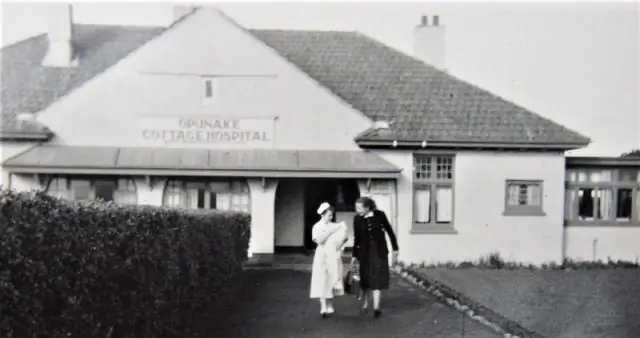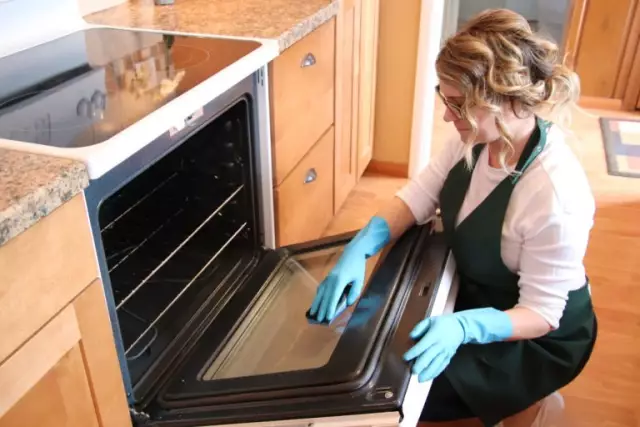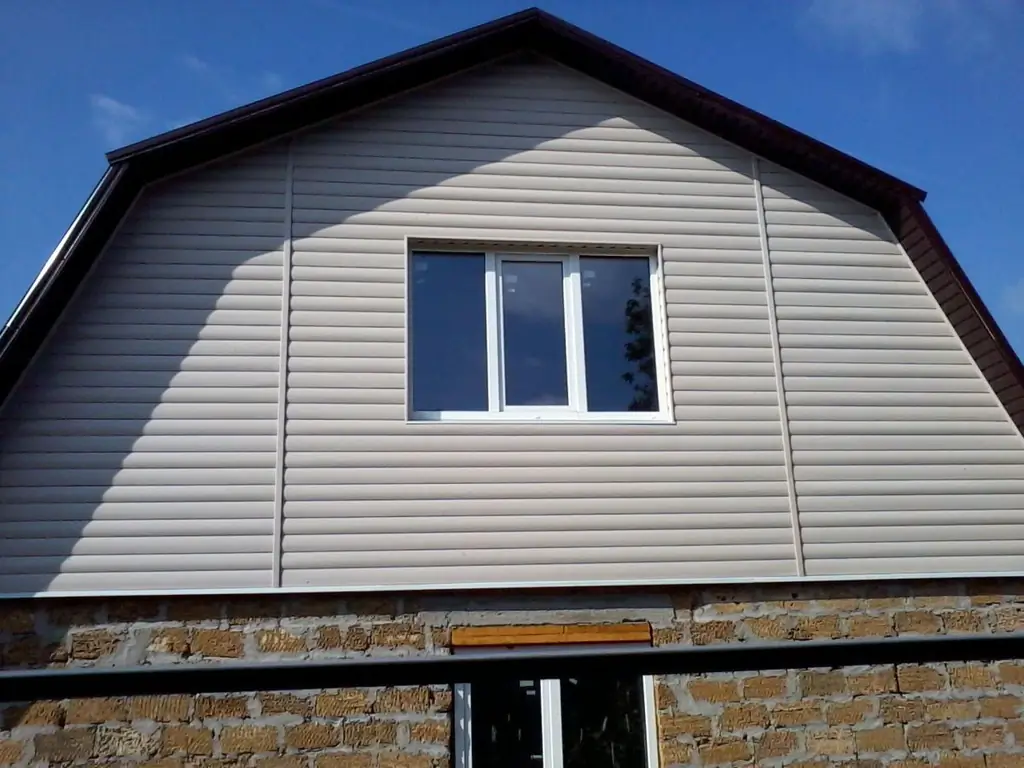
Table of contents:
- Author Bailey Albertson [email protected].
- Public 2024-01-17 22:26.
- Last modified 2025-06-01 07:32.
How to quickly, efficiently and inexpensively decorate a house: do-it-yourself lining the oven

If there is a stove in a private house, then it, like all other interior items, should be ennobled. When facing and finishing the stove, the preferences of the owners, the style of room decoration and practicality are taken into account. You can give a presentable look to your favorite heating tool with your own hands and with the help of various materials, which you can choose based on your preferences and material capabilities.
Content
-
1 Furnace lining and its purpose
- 1.1 Metal ovens
- 1.2 Brick kilns
-
2 Types of lining of furnace devices
- 2.1 Application of bricks
-
2.2 Use of ceramic tiles
- 2.2.1 Terracotta tiles
- 2.2.2 Clinker tiles
- 2.2.3 Majolica
- 2.2.4 Porcelain stoneware
- 2.3 Tiles
- 2.4 Facing a home stove with stone
- 2.5 Talcochlorite
-
2.6 Tree
2.6.1 Video: how to make tiles on a Russian stove
- 3 Required materials and tools
- 4 Preparatory phase
-
5 Decorating the oven with your own hands
- 5.1 Facing with ceramic tiles with your own hands
- 5.2 Plastering
- 5.3 Staining
- 5.4 Stone decoration
- 5.5 Furnishing the firebox
-
6 Decorating the stove in the house
6.1 Photo gallery: successful examples of do-it-yourself stove decor
Furnace lining and its purpose
Furnace lining is a process of changing its appearance. Moreover, the oven itself and the cladding can be made of different materials.
The cladding allows you to solve the following tasks:
- decorative;
- functional.
The decor of the stove can be completely different, it depends on the materials used and on the ideas of the designers. As for the functionality of the cladding, they must be taken into account when carrying out work independently.
It is very important that after changing the appearance of the furnace, its ability to perform its main task is not lost - to heat the room with high quality. The heat transfer of the furnace with proper lining increases. The possibility of penetration of combustible materials from the firebox into the dwelling is excluded, because when facing the furnace craftsmen do not leave any cracks, cracks in the furnace structure. Some imperfections (for example, cracks that appear) can be completely corrected by performing high-quality cladding.
A furnace without a lining becomes a source of dust accumulation. The surface of the "original" appearance of this heating device is much more difficult to maintain, and the lined stove can be wiped clean and any dirt can be removed. This allows not only to monitor its appearance, but also relieve allergy sufferers from problems.

The beauty of cladding can dramatically change the look of your oven.
Metal ovens
Be sure to keep in mind that it is not worth tiling metal ovens with ceramic tiles because of the difference in the heating coefficients of these materials. Different times for heating and cooling of metal and ceramics will lead to the fact that the outer ceramic layer of the furnace will become unusable - cracks, cracks, etc. will appear. The only way out in this case is to create a movable bond between the tile and the metal furnace. For such furnace structures, the technology of using clasps is common among professionals.

Brick is a suitable material for the outer lining of the metal furnace
Brick ovens
Double-circuit brick ovens are most often tiled with ceramic tiles. On the outer contour of such a structure, the tile holds very well and does not need to be replaced with different brands. All work can be done with one material.
Single-circuit brick ("bath") ovens are faced with different solutions, adjusting both materials and bonding mixtures for different parts of the oven, paying special attention to local areas of strong heating. A porous, durable material - porcelain stoneware, as the most suitable for rooms with frequent temperature and humidity changes - is best suited for "bath" stoves.

Ceramic tiles of a variety of designs will help you refine your brick oven
Types of lining of furnace devices
Before carrying out work on the lining of the furnace, you should very carefully select the material to change the appearance of the furnace device. Properties to consider when choosing materials:
- high temperature resistance;
- good heat dissipation;
- mechanical reliability, practicality;
- adhesion strength with mortar;
- aesthetic appeal.
Most often, materials with a thickness of at least 6 mm with a low-porosity structure are used for facing the furnace
For a long time, brick, natural stone, tile material, ceramic tile have been used to change the appearance of the stove. Modern industry offers an artificial stone for such work, as well as soapstone.
Brick application
Brick cladding can be done simultaneously with the laying of the oven itself. She can compete in beauty with such expensive materials as granite, marble.
For better adhesion, one of the surfaces of the brick must be rough, the outer side, on the contrary, must be flat in order to look the most aesthetically pleasing. Of course, refractory bricks should be used for such work. This material is also used to decorate a metal stove. To "smooth" the different heating characteristics of metal and brick surfaces, a layer of dry sand of fine consistency is placed between them. This step will prevent deformation of the decoration layer when the hot metal expands and will increase heat transfer.

Brick cladding drive the oven to the type that is most familiar to perception
Use of ceramic tiles
Glazed type ceramic tiles are suitable for cladding space heating devices, but they are limited in use. This is due to the fact that it will not be able to withstand temperature deformations, since it is not equipped with special hooks and locks. Some craftsmen combine brickwork and ceramic fragments when facing the stove. The combination of these materials looks good and is a practical way to enhance the appearance of the stove.

By combining materials such as bricks and ceramics, you can achieve a unique oven appearance
There are several types of ceramic tiles that can be safely used to decorate the stove:
- terracotta;
- clinker;
- majolica;
- porcelain stoneware.
Terracotta tiles
Terracotta notorious that can withstand the super-high temperature (up to 1000 of C). This tile is environmentally friendly, since no chemicals are used in its production, even as dyes. Natural shades of different clay give a color pleasant to the human eye. By using it, you can achieve optimal thermal conditions, since this material has a porous structure that retains heat well.

Terracotta tiles are very suitable for cladding ovens because of their heat resistance and beauty
Clinker tiles
Clinker tiles do not have such high heat transfer rates as terracotta type. But kiln craftsmen also use it for cladding. The undoubted plus of this material is long heat retention, although there is also a significant minus - slow heating. A kiln lined with clinker tiles can heat up to 1300 ° C.

The oven device with clinker tile trim looks modern and stylish
Majolica
It is named after the island of Mallorca, from where this material was brought to Russia. The very expensive decoration of fireplaces and stoves with this tile spoke of the high prosperity of the owners. The production technology is similar to the terracotta variety of tiles, except that a decorating layer of different colors and patterns is applied over the clay base. This fact significantly increases the cost of the material.

Only wealthy people can afford to cover the stove with majolica
Porcelain stoneware
Porcelain stoneware is a durable material with good moisture resistance and strength characteristics. The porcelain stoneware coating is resistant to various chemicals, so it can be washed with modern detergents.
Tiles
Furnace masters have long struggled to create a universal material that is resistant to temperature extremes, and therefore to thermal deformations. Tiles "render" significant help to stove-makers, because their special configuration made possible the practical use of clay tiles for facing stoves.

The beauty of tile-faced stoves makes them the center of attention
The back side of the tile was equipped with special projections (rump), which made it possible to reliably connect the array of masonry and tiles.

Thanks to the special design of the back side, the tiles adhere well to the stove
Special clamps-hooks are used to connect the tiles to each other, for the same purpose, the solution is used, placed in the inter-tile space and rump.

The true masters of this business possess the knowledge of the correct facing of stoves with tiles.
Working with tiles requires certain skills, so it is best to contact qualified specialists for facing these materials.
Facing a home stove with stone
For the exterior decoration of the stove, both natural stone and its artificial imitation can be used. Environmental friendliness, strength, durability, compliance with all the requirements of the stove device - these are the main characteristics that allow using natural stone for facing stoves and fireplaces. Such decor looks beautiful, elegant, luxurious. Of course, the cost of natural stone is quite high, so not all stove owners can afford such a finish.

Beautiful and expensive decoration of a fireplace with a real stone is expensive, but effective
In the case of a budget option, you can use an artificial stone, which in appearance is not inferior to the natural "brother". The production of artificial stone is less expensive, so the price of this material becomes much lower. At the same time, many properties of the natural material are preserved - a beautiful exterior, a wide range of colors and textures.

Externally, artificial stone almost does not differ from natural
Talcochlorite
This modern finishing material is a volcanic rock with excellent qualities suitable for furnace cladding:
- heat resistance;
- strength.
Its cost is high, most often this is due to skillful marketing. There are more economical and practical materials that can be used to enhance the appearance of the stove.

Facing material talcochlorite fits perfectly into a modern interior
Wood
Some wood inserts are also suitable for facade decoration, but no more. Such cladding does not conduct heat well and is fire resistant. It is best to use wood for lining the stove in fragments, making elements adjacent to the stove from this material: shelves, benches, corners. It is best to use wood for lining the stove in fragments, making elements adjacent to the stove from this material: shelves, benches, corners.

Wood looks great as a decoration when decorating a stove
Video: how to make tiles on a Russian stove
Required materials and tools
Before proceeding with the self-lining of the furnace, it is necessary to prepare all materials and tools. Depending on the facing material, attachment materials and tools are selected.
It is advisable to take from the tools for tiling:
- Master OK;
- spatulas made of different materials (rubber, metal) and different sizes;
- measuring instruments (ruler, centimeter, plumb line, level, etc.);
- devices for cutting tiles, grinder;
- rule;
- drill with a special nozzle for stirring the solution;
- rubber or wooden hammer;
- shovel;
- container for solution;
- metal brush;
- brush.
Materials that will be needed for facing with ceramic tiles:
- special composition for gluing;
- grout for joints;
- the tile itself;
- Rabitz.
Preparatory stage
In order for the ceramic tiles used for cladding to not fall off and serve for a long time and with high quality, the work surface must be prepared. The preliminary stage is to remove any old coating of the oven - whitewash, plaster, varnish, etc.
If the masonry of the stove is old, then it is worth carefully examining it and eliminating possible defects. All cracks, holes, crevices must be covered, wait until it is completely dry and then sanded this surface. You will have to resort to leveling the walls if the device is askew. Curved surface can hardly serve as a good "platform" for strengthening the cladding. For leveling, it is necessary to use a sand-cement mixture (at the rate of 3: 1), cement is suitable with a grade of at least M400. To keep the walls even and beautiful, do not forget to pick up a plumb line or a building level more often.

In the process of leveling the furnace walls, special equipment is indispensable
The joints between the bricks should not be thick or protruding. It is best to deepen them with a grinder with a specially designed nozzle. 10 mm will be sufficient. If there are no such devices, then you will have to use the "old-fashioned" method - a chisel with a hammer. After this procedure, clean the edges of the recesses with a metal brush.
A mesh netting placed between the brickwork and the ceramic surface will help to avoid various troubles arising from temperature extremes (cracks, chips, distortions, voids, etc.). To keep the metal mesh firmly on the brickwork, use dowels (or 70-100 mm nails) in the brick joints with a 50 cm spacing. The hats of the fasteners should protrude ten millimeters from the surface.
To give the working surface greater adhesion (adhesive properties), a deep penetration primer layer is applied over the chain-link. Wait until the layer is completely dry, clean it and start laying ceramic tiles.

The stage of fastening the mesh of the chain-link will help in the future better docking of the ceramic plates
Decorating the oven with your own hands
There are several types of work on finishing the furnace device with your own hands: plastering, lining with ceramic tiles, painting, facing with a stone, etc. There are often cases of using several materials at once.
Do-it-yourself ceramic tile cladding
After carrying out the preparatory work and collecting the necessary materials and tools, you can start working.
- Choose a place in the oven from which the ceramic plates will be glued. It is best to start at the bottom right or left corner. When laying out tiles, check each of them for evenness, and also do not forget about the plumb line, using it to lay even rows. Use a notched trowel to apply the adhesive to the tiles.
- Before laying out the bottom first row, install a steel profile in the shape of the letter "L" or a regular wooden lath, on which the first row will "rest". The fixation of the lower row in this case will be more reliable.
- To make the seams between the tiles even and beautiful, use special mounting crosses.
- You can correct the position of the tiles with a rubber mallet, lightly tapping the ceramic surface.
- Having laid out the main part with full-sized tiles, you can proceed to facing areas where the whole tile does not fit. Using tile cutters, lay out any remaining areas of the oven gradually.
- Try to erase the traces of the adhesive mass remaining on the tiles until they harden, otherwise it will be much more difficult to do.
Do not rush to grind the joints between the tiles until the glue is completely dry. Leave the oven alone for 2-3 days, and only then start rubbing the seams. If you want to give the ceramics an even more presentable look, then cover the veneer with colorless stone varnish using a soft brush (1-2 coats).

Cladding with ceramic tiles helps to change the exterior for the better
Plastering
Plastering a stove is the easiest way to transform the look of this appliance for warmth. Before embarking on finishing work, all owners of "newly-made" ovens must withstand a month's time.
The most commonly used materials are dry heat-resistant mixtures. The prepared solution is applied in layers with a time period between them of at least four hours. The mixture for the first layer can be used in a more liquid state than for all subsequent layers. In total, you can apply 3-4 layers.

Plastering of the stove is used by many of their owners, since it is much easier than cladding
Coloration
Various paints and whitewash can be purchased for staining. Moreover, the surface to be painted can be either brick or plastered. Whitewashing is most often used chalk or lime. So that the layers do not crumble in the future, oven masters advise adding ordinary salt to the whitewash. This color option is suitable for adherents of the use of environmentally friendly materials.
There are also heat-resistant chemical compounds that you can use to paint the furnace yourself: alkyd, silicate, silicon.

The color for painting the oven device can be selected depending on the style of the room
Stone decoration
- Working surface priming.
- Laying out the first bottom layer using a special compound. Level is an essential tool when aligning rows.
- Fragments of stone are cut using a grinder with a disc for concrete.
-
The seams between the elements of the masonry are sewn using plasterboard parts of the desired size.

Furnace stone furnace The choice of material (natural or artificial) often depends on the financial capabilities of the owner of the furnace device
Furnace finishing
The firebox is finished with the same materials as the furnace itself. The main condition for choosing materials is safety, fire resistance, reliability, strength. When designing a firebox, special attention should be paid to fire safety rules, because this part is most directly related to fire.
It is very important to leave a gap between the firebox and the oven lining. This is necessary for free air circulation, which affects the efficiency of its work in general. It is not advisable to fill this gap with sand or thermal insulation material. It will become a reliable barrier to deformation of the facing material. If there is a gap, then the finishing material will not crack, voids and other negative points will not appear in it.
When using drywall structures, leaving a gap will be an additional means of preventing fire. 10 centimeters is the smallest gap that must be left between the firebox and the stove for safety reasons.
Decorating the stove in the house
The techniques that craftsmen can use for decorating are very diverse:
- painting;
- decoupage;
- use of stencil stamps;
- decoration with decorative stone.
Various fragments of decorative elements, introduced in certain places of the stove, can make this heating device unique and memorable.
Photo gallery: successful examples of do-it-yourself stove decor
-

Stone decor - Decorative stone on the walls of the stove looks great
-

Furnace decor - Furnace decor using different techniques and materials looks unusual and impressive
-

Decoupage oven - Fragments of the pattern can be applied using paper towels and glue
-

Wooden shelves above the stove device - Using the shelves to decorate the epaulette is not only beautiful but also functional
-

Application of stamps for decoration - You can use ready-made stamps to decorate the stove or create your own
-

Stove painting - Painted decor can be created by craftsmen with artistic skills
-

Furnace painting - Uncomplicated drawings will significantly improve the visual perception of the furnace.
-

Decorating the oven surface with a patterned roller - You can add luminosity to the oven using stencil technology - it can be facilitated by using a roller with a printed pattern
-

Furnace finishing - Real masterpieces in decoration can be created by masters of stove making
Furnace cladding is an interesting and exciting process. Applying your imagination and applying your skills, you can create samples of unique heating devices. A stove that looks like a sour and wretched means of heating a room is a thing of the past. Currently, this device is becoming a full-fledged item in any interior and, like all other interior elements, needs decoration.
Recommended:
How To Make A Veranda With Your Own Hands To The House - Instructions, Projects, Drawings, Photos And Videos

The article describes how to build a veranda close to the house with your own hands
How To Make A Fence With Your Own Hands From Scrap Materials: Step-by-step Instructions For Making And Decorating From Plastic Bottles, Tires And Other Things, With Photos And Vide

How to make a hedge with your own hands. Choice of material, pros and cons. Required instructions and tools. Tips for finishing. Video and photo
How To Clean A Stove With Your Own Hands - Repair, Cleaning A Brick Russian, Bath, Round Stove From Soot Without Disassembling Why It Does Not Heat Well, Reasons, Cleaning Wells, G

How to repair and clean the oven with your own hands. Types of repair, when and why you need it. List of necessary tools and nuances to consider
How To Insulate The Roof From The Inside In A Private House With Your Own Hands: Step-by-step Instructions With Photos And Videos

How to insulate the roof with your own hands: from the choice of insulation to the rules of installation. Preparation of tools and materials. Complete instructions for roof insulation
Decorating The Gable Of The House With Siding With Your Own Hands: How To Calculate And Sheathe Correctly + Video

Finishing the gable with siding: device, material calculation, preparation for work and all the nuances of panel installation. Reviews of siding as a material for the pediment
